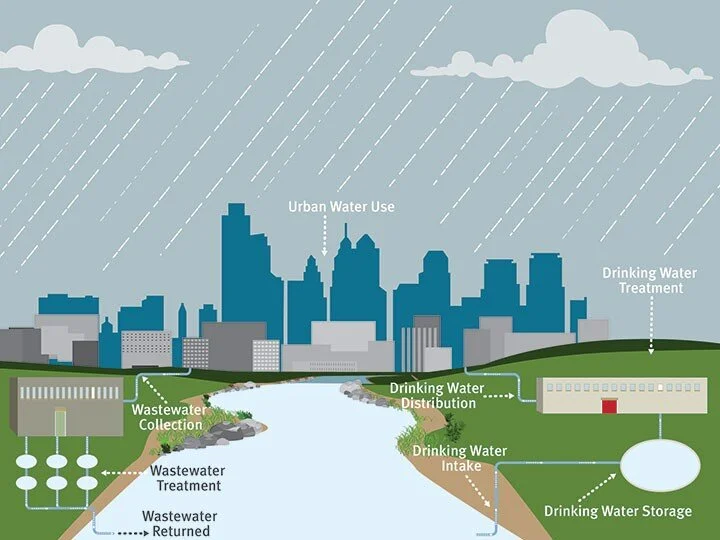By Nathan Walker
Benchmarking is the practice of comparing processes via performance metrics against each other, in order to ascertain a best practice for that process for others to learn from. The process in question can almost be anything, from rollercoasters and snooker chalk (yes, really) to pumps and water companies. Due the nature of our project, water companies were the subject of benchmarking in this research. Despite the UK water sector being mature in benchmarking, we believed we could add extra value to the companies, as well as academia, by applying new methodologies to analyse the efficiency of their operations, along with factors that may influence those efficiencies.
Figure 1. A basic schematic of the operations that a water utility conducts.
Initially, the approach in benchmarking comprised of stand-alone indicators (e.g. volume of water produced). Then to encompass at least some fairer level of comparison, partial indicators became prominent such as volume of water produced/population served and spending/volume of water treated. In academia, benchmarking has largely branched in to techniques that are slightly more complex. We chose data envelopment analysis (DEA), a non-parametric frontier approach to analyse a sample of UK and Irish water and sewage companies, which has the advantage of integrating multiple input and output metrics, and giving a value for each company that is determined relative to others in the sample. Specifically, we utiltised a double-bootstrap version of DEA that allows statistical inferences and hypothesis testing, essentially meaning we could investigate how other indicators may influence the efficiency of a company’s core operation (inputting energy and money to produce clean drinking water and treat wastewater), whilst avoiding some statistical errors that occur with techniques that similar objectives.
Results from the research indicated that companies across the UK and Ireland could on average reduce their economic and energy inputs by 19% and 16%, whilst maintaining the same levels of water delivery and treatment outputs. Furthermore, we found that the method we used changed the rank of over 65% of the companies, compared to the standard DEA model, showing the importance of utilising the most appropriate approach design. Finally, research so far has highlighted external variables that influence efficiency. Population density and the percentage of water abstracted from surface water showed to have a significant positive impact on both economic and energy efficiency, whilst leakage and number of abstraction sources were concurrent in their significantly negative influence across both energy and economic performance. Moreover, average pumping head height and consumption per capita displayed a significant negative effect for energy, conversely the variable proportion of water passing through the largest 50% of treatment works was deemed to have a significant negative effect on economic efficiency. Recommendations from this area of the research so far include: reduction campaigns for consumers, leakage reduction, evaluating security of supply vs. efficiency for number of sources, assess the potential to reduce head heights within new and existing networks, and investigate the optimal size of treatment plant to utilise economies of scale.
Some of these results are quite rare, whilst some may seem more obvious, however giving evidence towards certain areas helps to inform decision-making and prioritisation. This is one of the key advantages that benchmarking can offer, along with identifying those who have best practice, the idea being that the benchmarking ultimately facilitates sharing of these best practices. To ensure benchmarking can facilitate companies to perform optimally, improvements in transparency and communication is still required, which in theory is one of the easier hurdles to leap since the water sector already collects and stores the crucial data.

